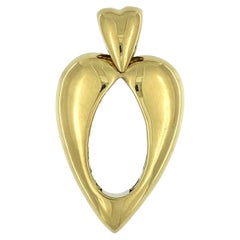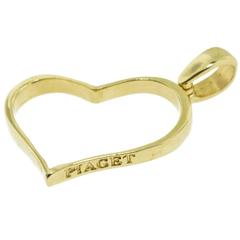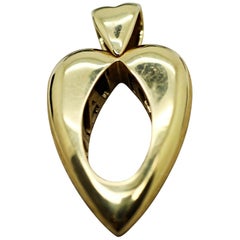Piaget Heart Pendant
21st Century and Contemporary Swiss Modern Pendant Necklaces
18k Gold, Yellow Gold
21st Century and Contemporary Swiss Pendant Necklaces
Diamond, Peridot, 18k Gold
Early 2000s Pendant Necklaces
Diamond, White Diamond, 18k Gold, White Gold
Recent Sales
Vintage 1980s Pendant Necklaces
Yellow Gold
21st Century and Contemporary Swiss Modern Pendant Necklaces
18k Gold, Yellow Gold
21st Century and Contemporary Pendant Necklaces
Diamond, 18k Gold, White Gold
21st Century and Contemporary Pendant Necklaces
18k Gold, Yellow Gold
Early 2000s Pendant Necklaces
Diamond, 18k Gold, White Gold
2010s French Pendant Necklaces
Diamond, Gold, White Gold
21st Century and Contemporary Pendant Necklaces
White Gold
20th Century Swiss Drop Necklaces
Diamond, White Gold
21st Century and Contemporary Swiss Chain Necklaces
White Diamond, 18k Gold, White Gold
People Also Browsed
21st Century and Contemporary Drop Necklaces
Diamond, 18k Gold
21st Century and Contemporary French Top Handle Bags
Late 20th Century French Artist Link Necklaces
Diamond, Pearl
20th Century French Pendant Necklaces
Diamond, White Diamond, Gold, 18k Gold, Yellow Gold
20th Century European Modern Pendant Necklaces
Diamond, 18k Gold, White Gold
2010s Wrist Watches
Rose Gold
1990s French Modern Pendant Necklaces
Malachite, Gold, 18k Gold, Yellow Gold
1990s French Drop Necklaces
Diamond, Gold, 18k Gold, Yellow Gold, White Gold
20th Century Romantic Drop Necklaces
Diamond, Cultured Pearl, 18k Gold, Yellow Gold, Gold
Early 2000s French Cocktail Rings
Diamond, White Gold
21st Century and Contemporary French Wrist Watches
Diamond, White Diamond, 18k Gold, Rose Gold
Vintage 1950s Cluster Rings
Diamond, Platinum
21st Century and Contemporary Italian Modern Fashion Rings
Diamond, 18k Gold, White Gold
Piaget for sale on 1stDibs
In 1874, at age 19, Georges-Édouard Piaget (1855–1931) began manufacturing handmade timepiece components and movements in a workshop on his family farm in La Côte-aux-Fées, Switzerland. The company expanded into luxury wristwatches and pocket watches under the direction of Georges-Édouard’s son, Timothée Piaget. Later, Timothée’s sons, Gérald and Valentin Piaget, would lead a team of talented craftspeople into a new era of innovation for the brand in both watches and luxury jewelry.
The Piaget family name was trademarked in 1943 and a large manufacturing facility was established in La Côte-aux-Fées. There they would perfect one of their signatures: ultra-thin movements. Valentin urged his design team to “do what has never been done before.”
In 1959, the Salon Piaget was opened in Geneva, where Piaget also set up workshops for goldsmithing and gem setting, introducing the company’s inaugural jewelry creations and establishing a creative hub where artisans were encouraged to push the boundaries of their designs. In 1963, Piaget released its first collection of watches with ornamental stones set into their dials (the brand's stone-dial watches are undeniable classics of watchmaking).
These artful creations caught the eye of such storied tastemakers as Jacqueline Kennedy Onassis, Elizabeth Taylor, Andy Warhol and Sophia Loren. In 1967, Yves Piaget collaborated with Salvador Dalí on a collection with pieces featuring the Dalí d’Or gold medals of the artist and his wife, Gala. Gala would also inspire the 1973 Limelight Gala timepiece and the subsequent collection.
Luxury jewelry designed by the company’s artisans has often cleverly reflected Piaget’s watchmaking origins, like the Possession collection, whose swinging pendants and turning rings nod to the movement of its watches. The Rose and Sunlight collections of bracelets, earrings and necklaces, meanwhile, reflect natural themes with a bit of Art Deco style. Piaget’s watches, likewise, have embodied an inventive approach to design, such as the Piaget Polo watch, which was introduced in 1979, popular for its luxurious refinement and widely imitated in the 1980s.
In 2001, the Piaget Haute Horlogerie was opened outside of Geneva, a facility that advanced its work in watchmaking and jewelry. The Swiss luxury watchmaker and jeweler now operates as part of the Richemont Group.
Find Piaget rings, necklaces, watches and other jewelry on 1stDibs.
Why Gold Shines in Jewelry Craftsmanship
Gold is the feel-good metal, the serotonin of jewelry. Wear vintage and antique gold necklaces, watches, gold bracelets or gold rings and you feel happy, you feel dressed, you feel, well, yourself.
Gold, especially yellow gold, with its rich patina and ancient pedigree going back thousands of years, is the steady standby, the well-mannered metal of choice. Any discussion of this lustrous metal comes down to a basic truth: Gold is elementary, my dear. Gold jewelry that couples the mystique of the metal with superb design and craftsmanship achieves the status of an enduring classic. Many luxury houses have given us some of our most treasured and lasting examples of gold jewelry over the years.
Since its founding, in 1837, Tiffany & Co. has built its reputation on its company jewelry as well as its coterie of boutique designers, which has included Jean Schlumberger, Donald Claflin, Angela Cummings and Elsa Peretti. There are numerous gold Tiffany classics worth citing. Some are accented with gemstones, but all stand out for their design and the workmanship displayed.
For the woman who prefers a minimalist look, the Tiffany & Co. twist bangle (thin, slightly ovoid) is stylishly simple. For Cummings devotees, signature pieces feature hard stone inlay, such as her pairs of gold ear clips inlaid with black jade (a play on the classic Chanel black and tan), or bangles whose design recalls ocean waves, with undulating lines of lapis lazuli and mother-of-pearl. And just about any design by the great Jean Schlumberger is by definition a classic.
Even had he eschewed stones and diamonds, Southern-born David Webb would be hailed for the vast arsenal of heavy gold jewelry he designed. Gold, usually hammered or textured in some manner, defines great David Webb jewelry. The self-taught jeweler made very au courant pieces while drawing inspiration from ancient and out-of-the-way sources — East meets West in the commanding gold necklaces made by Webb in the early 1970s. The same could be said for his endlessly varied gold cuffs.
In Europe, many houses have given us gold jewelry that sets the highest standard for excellence, pieces that were highly sought after when they were made and continue to be so.
Numerous designs from Cartier are homages to gold. There are the classic Trinity rings, necklaces and bracelets — trifectas of yellow, white and rose gold. As a testament to the power of love, consider the endurance of the Cartier Love bracelet.
Aldo Cipullo, Cartier’s top in-house designer from the late 1960s into the early ’70s, made history in 1969 with the Love bracelet. Cipullo frequently said that the Love bracelet was born of a sleepless night contemplating a love affair gone wrong and his realization that “the only remnants he possessed of the romance were memories.” He distilled the urge to keep a loved one close into a slim 18-karat gold bangle.
BVLGARI and its coin jewelry, gemme nummarie, hit the jackpot when the line launched in the 1960s. The line has been perennially popular. BVLGARI coin jewelry features ancient Greek and Roman coins embedded in striking gold mounts, usually hung on thick link necklaces of varying lengths. In the 1970s, BVLGARI introduced the Tubogas line, most often made in yellow gold. The Tubogas watches are classics, and then there is the Serpenti, the house's outstanding snake-themed watches and bracelets.
A collection called Monete that incorporated the gold coins is one of several iconic BVLGARI lines that debuted in the 1970s and ’80s, catering to a new generation of empowered women. Just as designers like Halston and Yves Saint Laurent were popularizing fuss-free ready-to-wear fashion for women on the go, BVLGARI offered jewels to be lived in.
Since Van Cleef & Arpels opened its Place Vendôme doors in 1906, collection after collection of jewelry classics have enchanted the public. As predominantly expressed in a honeycomb of gold, there is the Ludo watch and accessories, circa the 1920s, and the golden Zip necklace, 1951, whose ingenious transformation of the traditional zipper was originally proposed by the Duchess of Windsor. Van Cleef's Alhambra, with its Moroccan motif, was introduced in 1968 and from the start its popularity pivoted on royalty and celebrity status. It remains one of VCA’s most popular and collected styles.
Mention must be made of Buccellati, whose name is synonymous with gold so finely spun that it suggests tapestry. The house’s many gold bracelets, typically embellished with a few or many diamonds, signified taste and distinction and are always in favor on the secondary market. Other important mid-20th-century houses known for their gold-themed jewelry include Hermès and Ilias Lalaounis.
Find a stunning collection of vintage and antique gold jewelry on 1stDibs.
Finding the Right Pendant-necklaces for You
Whether you’re layering multiple jewelry pieces or opting for a single strand, vintage pendant necklaces are versatile accessories that can elevate your casual wear as easily as they can add a creative flourish to your formal attire.
The earliest jewelry was less about accessorizing than it was about wearers arming themselves with amulets. In Ancient Egypt, some amulets featured a loop so that they could be strung around one’s neck. While rubies have long been one of the few gemstones that can give diamonds a run for their money, members of some ancient civilizations valued the stones from the get-go, donning ruby pendants as well as other stones with the belief that these adornments would bring protection, healing powers or strength. Today, we still wear our charm bracelets and charm pendants around our necks for good luck.
Later, pendant necklaces, like most fine jewelry, were worn strictly by royalty or the upper class and conferred wealth and prestige. This changed over time, thankfully, as wearing jewelry became more widespread, a democratized means of personal expression.
During the 18th and 19th centuries, pendant necklaces evolved from their status as spiritual amulets, but the jewels still carried deep personal significance. Victorian pendants, in particular, were part of the “mourning jewelry” tradition. Wearers would embed their pendants with locks of hair from a deceased loved one as a way of grieving in the wake of a loss. In the case of cameo jewelry, some pendants were even decorated with miniature hand-carved portraits in a detailed raised relief. Today, portraiture is still a characteristic of many of the hand-carved pendant necklaces offered by Italian jewelry house Scala Gioielli.
Luxury fine jewelry brands such as Cartier, BVLGARI and David Yurman offer their own unique interpretations of the cherished accessory, embellishing platinum or gold pendant necklaces with diamonds, sapphires and other stones.
On 1stDibs, find an extraordinary range of vintage pendant necklaces and other necklaces today.




